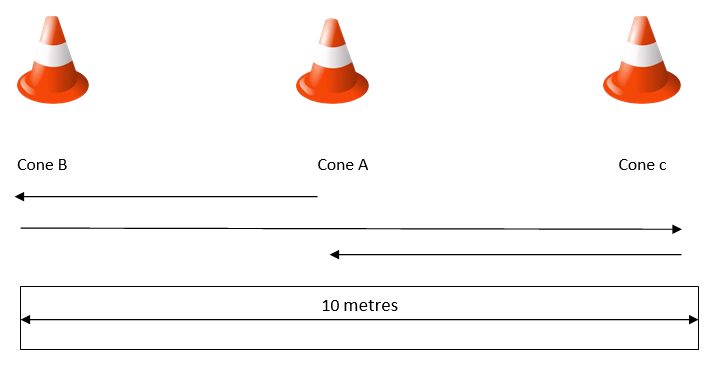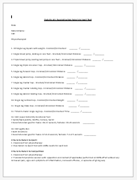Return to sport test
exp date isn't null, but text field is
This series of tests are designed to make sure the patient is ready to return to sport therefore it is important that prior to commencing these tests the patient must be able to tolerate all exercises for strengthening, agility, running, sprinting and plyometrics with no reports of pain, instability, signs and symptoms of inflammation or notable compensation strategies.
1. 10 Single Leg Squats
The patient must squat down on one leg at least 60° of knee flexion while maintain balance and motor control. The patient cannot allow their knee to deviate into genu varum or valgum. The patient must complete 10 consecutive repetitions.
2. Single Broad Jump, landing on one foot
Starting at a designated line, the patient will jump using both legs as far forward as possible, landing on one foot and maintaining balance. To pass, the involved leg must measure at least 90% of the distance compared to the uninvolved leg.
3. Triple Broad Jump, landing on one foot
Starting at a designated line, the patient will jump using both legs three consecutive times. The patient must land on one foot after the third jump and maintain their balance. To pass, the involved leg must measure at least 90% of the distance compared to the uninvolved leg.
4. Single Leg Forward Hop
Starting at a designated line, the patient will balance on one leg and hop forward as far as possible, landing on the same leg. The patient must maintain their balance. To pass, the involved leg must measure at least 90% of the distance compared to the uninvolved leg.
5. Timed 6-metre Single Leg Hop
Starting at a designated line, the patient will balance on one leg and hop as fast as they can consecutively a distance of 6 meters. To pass, the involved leg must hop 6 meters in at least 90% of the time compared to the uninvolved leg. (6 meters = 19.7 feet)
6. Single Leg Triple Hop
Starting at a designated line, the patient will balance on one leg and hop forward three times consecutively as far as possible, landing on the same leg. The patient must maintain their balance on the last hop. To pass, the involved leg must measure at least 90% of the distance compared to the uninvolved leg.
7. Single Leg Triple Crossover Hop
Starting at a designated line, the patient will balance on one leg and hop medially at a 45° angle as far as possible, immediately hop laterally at a 45° angle, and then immediately hop medially again at a 45° angle, landing on the same leg. The patient must maintain their balance on the last hop. To pass, the involved leg must measure at least 90% of the distance forward compared to the uninvolved leg.

8. Single Leg Lateral Hop
Starting at a designated line, the patient will balance on one leg and hop laterally as far as possible, landing on the same leg. The patient must maintain their balance. To pass, the involved leg must measure at least 90% of the distance compared to the uninvolved leg.
9. Single Leg Medial Hop
Starting at a designated line, the patient will balance on one leg and hop medially as far as possible, landing on the same leg. The patient must maintain their balance. To pass, the involved leg must measure at least 90% of the distance compared to the uninvolved leg.
10. Single Leg Medial Rotating Hop
Starting at a designated line, the patient will balance on one leg and hop straight up in the air rotating medially as far as possible, landing on the same leg. The patient must maintain their balance. To pass, the involved leg must measure at least 90% of the angle (e.g. 135°) compared to the uninvolved leg.
11. Single Leg Lateral Rotating Hop
Starting at a designated line, the patient will balance on one leg and hop straight up in the air rotating laterally as far as possible, landing on the same leg. The patient must maintain their balance. To pass, the involved leg must measure at least 90% of the angle (e.g. 135°) compared to the uninvolved leg.
12. Single Leg Vertical Hop
While balancing on one leg and using the arm on the same side as the testing leg, the patient will reach vertically as far as possible without straining. The height to the tip of the patient’s middle finger will be measured. The patient will balance on one leg and hop vertically as far as possible
reaching with the same arm. The difference between the original standing height and the hopping height will then be measured. To pass, the involved distance must measure at least 90% of the distance compared to the uninvolved leg.
13. 10 metre Lower Extremity Functional Test
Starting at cone A, the patient will sprint 10m forward to cone B then backpedal to cone A.
Next, the patient will side shuffle to cone B then side shuffle back to cone A. Then the patient will carioca to cone B then carioca back to cone A. Finally, the patient will sprint through cone B. The patient must make sure to touch each line with his/her foot. The physiotherapist will measure the time it takes the patient to complete the test. (Males ≤ 17-20 seconds; Females ≤ 19-23 seconds) See diagram.
14. 10 metre Agility Run
The patient will start at cone A facing cone C and will turn and sprint 5m back towards cone B. Then the patient will sprint 10m to cone C. Finally, the patient will sprint 5m through line A. The patient must make sure to touch each line with his/her hand. The physiotherapist will measure the time it takes to patient to complete the test. This test will be completed in reverse order (A to C to B to A) to make sure the patient is planting with both the involved and uninvolved foot. (Males ≤ 4.5-5.5 seconds; Females ≤ 5.5-6.5 seconds) see diagram.



